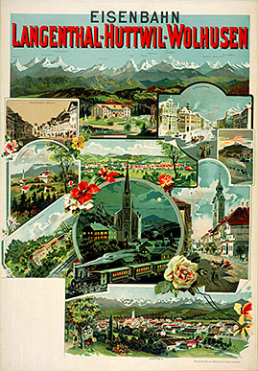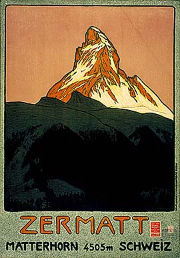Tourism came to Switzerland towards the end of the 19th century. Whole countries, individual resorts and transport firms vied for travellers’ attention, and they found the poster to be an ideal promotional medium.
Early tourism posters often comprised a mix of local views and tourist information such as timetables and maps. As the 19th century gave way to the 20th, these various informative elements coalesced into a simplified, general visual statement, with one eye-catching and symbolic image depicting a destination’s picturesque qualities and tourist appeal.

Posters in the traditional style were used from 1880 onwards to promote tourist resorts in Switzerland. They had the following characteristics:
- They showcased a particular region’s beauty and range of leisure pursuits.
- A number of small images were arranged around a central image, together with a map and/or a timetable for trains or boats.
First poster competition
Swiss Federal Railways held a competition in 1903 to design six promotional posters for various attractions. The response was huge. Renowned Swiss artists entered, enhancing the poster’s artistic significance. Prizes were awarded mainly to young artists like Plinio Colombi, Edmond Bille and Jules Courvoisier, whose posters stood out through their composition and imagery.
- Rather than a collection of disparate images, they depicted a single, characteristic landscape from a given region.
- The sights themselves now took centre stage, not the means of transport or tourist infrastructure.
- The pictures showed locals, not tourists.
- They emphasised the idyllic charm of the places depicted.
Emil Cardinaux’s Matterhorn poster

One of the most iconic posters from this era is Emil Cardinaux’s 1908 image of the Matterhorn. It has influenced all portrayals of Switzerland’s mountains and tourist destinations to this day, for the following reasons:
- The larger-than-life depiction of the mountain, painted with simple lines in broad strokes of warm colour, dominates over the dark foreground.
- The Matterhorn symbolises the beauty of an entire region.
- From a visual and stylistic standpoint, it combines the sober monumentality of German art with contrasting colours and playful lines, which have a distinctly French feel.
This synthesis served as a blueprint for a typically Swiss style of poster.
Last modification 07.12.2018
Contact
Swiss National Library
Prints and Drawings Department
Hallwylstrasse 15
3003
Bern
Switzerland
Phone
+41 58 462 89 71





